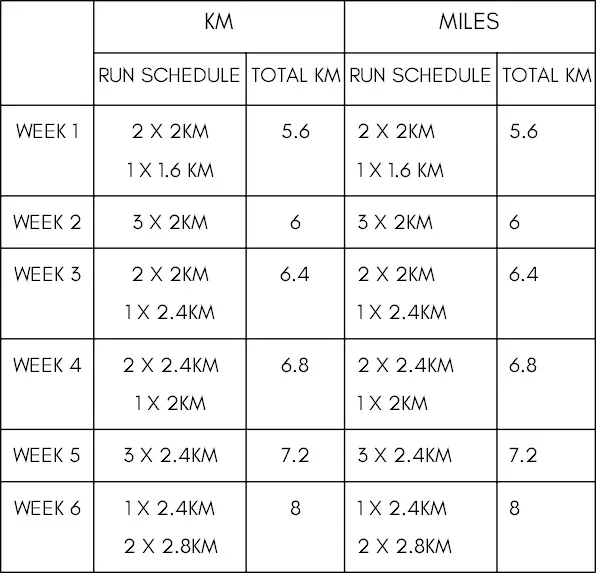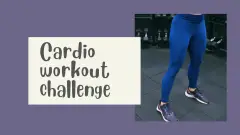The starting point for this running schedule for improvers is that you should be able to run 1.25 miles/2km. (If you’re not at this level, then do this program first). The aim of the schedule is to complete a total of 25 miles/40km over 6 weeks. It starts with two 1.25 mile/2km runs and a slightly shorter 1 mile/1.6km run in the first week and then progresses the distances each week.
Running schedule for improvers
Here’s the schedule – in both miles and km. The total distance increases by just 0.25 mile/0.4 km each week, apart from the final week when it increases by 0.5 mile/0.8 km.
How to run safely
As this isn’t a complete beginners plan, you’re probably already aware of exercise safety, but please check these guidelines. Please also be aware of personal safety when choosing the time and location of your run.
You should warm your muscles and joints up before running, either by a couple of minutes of walking, or by doing this warm up routine. You should also walk at the end of your run, until your heart rate returns to normal.
When your heart rate has recovered, but before your body has cooled down, is an ideal time to stretch. Stretching helps us to stay flexible and avoid injury. For runners, stretching the calf muscles is particularly important. This stretching routine will stretch all the major leg muscles.
Planning a route
You can map out a route of the right length for each run, using an online route planner or a smart phone app. Alternatively, if you know your running speed, you can work out how long the run will take you. Once you have worked this out, you just need to run for half the time, then turn around and run back. (An app like Strava or a fitness tracker watch will tell you your running speed for any run that you record.)
Buying a treadmill for home use
Now that folding treadmills are widely available, having a home treadmill doesn’t mean you need a dedicated workout space. You can fold your treadmill up and store it out of the way between workouts. If you’re thinking of buying a home treadmill, here are some points you should consider:
- If you’re going to be using the treadmill for running, avoid very lightweight models that are only suitable for walking speeds. Also, a cushioned running/walking deck will help to absorb impact.
- Dimensions: there’s a slight variation in dimensions between models. If you’re tall, you might prefer a longer walking/running deck to allow for a longer stride. Obviously, the treadmill needs to fit in your chosen storage place when it is folded away.
- What sort of a console do you want? Is it important to you to have a multi-feature console with a choice of preset programs, or will you be happy with something simple that just lets you set speed and incline? Extra functions add to the cost of the treadmill, so think about whether you really need them.
- What is the incline range? Some treadmills only have a limited incline range. Models that offer up to 12% give you more options to vary your workouts and to challenge yourself more as your fitness improves.
- Maximum speed – if you run fast, or plan to do sprint intervals, you should bear the maximum speed in mind. For walking, or average speed running, any treadmill will be fine.
See a treadmill buying guide here.


